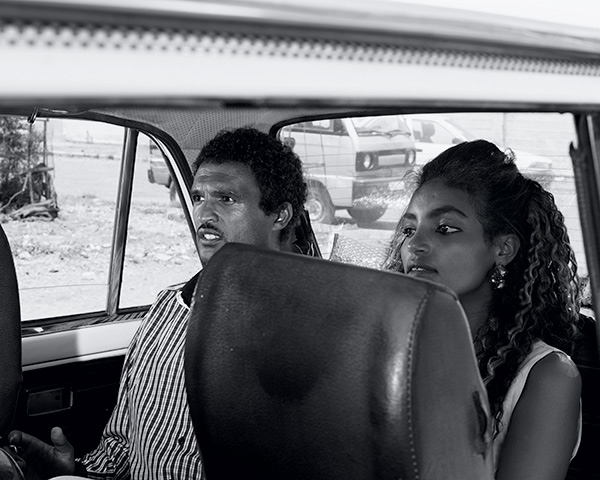Spotlight: Eli Durst

Eli Durst, Photographer, from the series In Asmara, 2015
Courtesy the artist
Eli Durst spent his summers during high school and college assembling asylum applications at the Austin immigration clinic where his mother works as a legal advocate, often for refugees from Eritrea. Durst took passport photographs and met dozens of people who had crossed the U.S. border from Mexico after landing there by circuitous journeys and illegal means, fleeing Eritrea’s authoritarian government and standstill economy. Yet, some Eritreans spoke wistfully about the underrecognized allure of Asmara, the nation’s capital and a time capsule of early twentieth-century colonial Italian architecture.
In the 1930s, following four decades of colonization, Italian fascist forces imposed the charge of futurism on Asmara through hundreds of new buildings, often shaped like the era’s latest technology: airplanes, radios, trains. The invasion of British troops in 1941, during World War II, brought an end to the Italian colony and the architectural explosion. Today, buildings remain remarkably undisturbed after years of war and undemocratic regimes.
“That really interested me, this kind of a duality of people’s love for this place while they are doing everything they can to leave,” Durst told me recently. In the summer of 2015, Durst visited the city for the first time, arranging for the brother of an Eritrean translator who works with his mother’s clinic to serve as a guide. He showed Durst the city for a few days, but then was forced to report for military training—another reason Eritreans leave the country.

Eli Durst, Samson and Winta, from the series In Asmara, 2015
Courtesy the artist
Durst toured Asmara using a 2003 architectural survey, but found he was not allowed to photograph iconic buildings. Though still standing, the majority have fallen into disrepair. A 1930s swimming hall he wanted to photograph had, he learned, been closed for a decade, and buildings converted for government use were restricted. With limited accessibility, Durst focused on silent details, and took cues from the cinematic styles of Federico Fellini, Roberto Rossellini, and, most of all, Michelangelo Antonioni. “I couldn’t not see it that way,” Durst said. “Asmara looks so much like the world I’ve seen in these midcentury Italian films. Antonioni, particularly, conveys a certain beauty with an underlying tension, where you have this setting but it’s disintegrating.”
Durst’s sharply contrasted black-and-white images from Asmara are often devoid of people, though the sense remains that someone has just left or is soon to appear in the frame. The Roman lettering of AMOR on a building reflects up from a puddle of standing water. Untouched coffee cups crowd a brimming ashtray on a table. A place setting of food awaits a diner.
“All you can talk about is how beautiful it is, because everyone is afraid of being critical,” Durst said. Eritrea has no free press and one of the world’s worst records for free speech. Journalists who speak out against the government are imprisoned, email and Internet use are closely monitored, and foreign journalists are not allowed to enter the country. (Durst traveled under a tourist visa.)
Durst, a native Texan, took photography classes at Wesleyan University. After graduating in 2011, he moved to New York to learn more about photography, working at Griffin Editions and as an assistant for Joel Meyerowitz, whom he cites as an influence. Durst later attended the Yale University School of Art for his MFA, where he began to work on his Asmara portfolio.

Eli Durst, Steak, from the series In Asmara, 2015
Courtesy the artist
The retouched passport photographs that Durst took over the years in Austin (and now uses in his work, with applicants’ consent) punctuate the series and connect Durst’s engagement with Eritreans in Austin and Asmara. Other images have faces and bodies that are clipped, cropped, or seen at a distance.
In a photograph taken in the dining room of his nearly unoccupied hotel (tourism to Eritrea is made difficult by a government wary of Western agitators and influence), a waiter in suit and tie stands in front of a contemporarily dressed man seated alone among empty tables.
Durst’s trip coincided with Ramadan, and on Eid al-Fitr local photographers take pictures of celebrating families. One took notice of Durst. “All the younger photographers had digital and he had this old Olympus,” Durst said. “He saw me and I stood out. He took my picture and then pulled me aside and led me around the city.” The man didn’t speak English and Durst was without a translator, so during their hour-long tour Durst never learned his name. In Durst’s image of their encounter, the unknown photographer, his face obscured by the Olympus, trains his analog lens on Durst, a seeming nod to the obscured face of Thomas in the popular imagery from Blow-Up (1966), Antonioni’s seminal meditation on the medium of photography.
“With Antonioni, there are these complicated and often very scary political undercurrents,” Durst said. “That photographic tension exists in his films. That’s what was driving me.”
Eli Durst is the winner of the 2016 Portfolio Prize. His exhibition In Asmara is on view at the Aperture Gallery through February 4, 2017. Click here for more information about the Portfolio Prize, now open exclusively to Aperture subscribers.


























